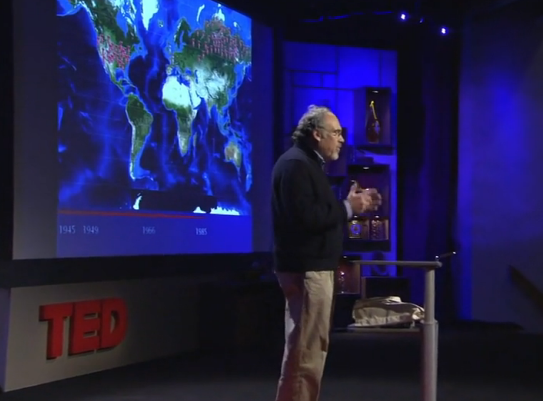So, a big question that we're facing now and have been for quite a number of years now:
我们现在面临一个大问题,这个问题已经持续了很多年:
are we at risk of a nuclear attack?
我们是否处于遭受核袭击的危险之中呢?
Now, there's a bigger question that's probably actually more important than that,
现在,有一个更大的问题,这个问题可能比刚刚提到的那个问题更重要
is the notion of permanently eliminating the possibility of a nuclear attack, eliminating the threat altogether.
那就是,我们能不能永久地消除核袭击的可能性,能不能将这种威胁完全消除
And I would like to make a case to you that
我想给大家举个例子
over the years since we first developed atomic weaponry, until this very moment,
从核武器被发明以来的这些年间,直到此时此刻
we've actually lived in a dangerous nuclear world that's characterized by two phases,
我们其实一直生活在一个危险的核世界,这可以分为两个阶段
which I'm going to go through with you right now.
我现在和大家一起来回顾一下
First of all, we started off the nuclear age in 1945.
首先,我们从1945年开始正式进入核时代
The United States had developed a couple of atomic weapons through the Manhattan Project,
美国通过曼哈顿计划成功研制出了核武器
and the idea was very straightforward:
目的非常明确
we would use the power of the atom to end the atrocities and the horror of this unending World War II
我们将动用核武器的力量来结束无休止的二战所带来的残暴与恐惧
that we'd been involved in in Europe and in the Pacific.
我们当时被卷入了欧洲和太平洋战场

And in 1945, we were the only nuclear power.
在1945年,我们是唯一的有核国家
We had a few nuclear weapons,
我们有一定数量的核武器
two of which we dropped on Japan, in Hiroshima, a few days later in Nagasaki, in August 1945,
其中一枚投在了日本广岛市,另一枚几天之后扔在了长崎,这些发生在1945年8月
killing about 250,000 people between those two.
这两枚原子弹一共造成25万人死亡
And for a few years, we were the only nuclear power on Earth.
之后的一些年间,我们一直是地球上唯一的有核国家
But by 1949, the Soviet Union had decided it was unacceptable to have us as the only nuclear power,
但是1949年,苏联认为只有美国拥有核武器是一件无法接受的事情
and they began to match what the United States had developed.
他们开始和美国一样发展核武器
And from 1949 to 1985 was an extraordinary time of a buildup of a nuclear arsenal
从1949年到1985年,这是一个特殊时期,一个核武器逐步发展的时期
that no one could possibly have imagined back in the 1940s.
如果是在40年代没有人可能会想到
So by 1985 -- each of those red bombs up here is equivalent of a thousands warheads --
到1985年的时候,地图上每一个红色炸弹标志都代表着1000枚核弹头
the world had 65,000 nuclear warheads,
整个世界一共有65000枚核弹头
and seven members of something that came to be known as the "nuclear club."
有7个国家先后拥有了核武器成为了一个叫做“核俱乐部”组织的成员
And it was an extraordinary time,
这是一个特殊时期
and I am going to go through some of the mentality that we --
我一会儿将讨论一下
that Americans and the rest of the world were experiencing.
美国人以及其他国家的人对此的思考
But I want to just point out to you that 95 percent of the nuclear weapons at any particular time since 1985 -- going forward, of course --
但我想先向大家指出自1985年以来的任何一个时间点,全世界百分之九十五的
were part of the arsenals of the United States and the Soviet Union.
核武器被储存在美国和苏联的军火库中
After 1985, and before the break up of the Soviet Union,
从1985年到苏联解体的这段时间
we began to disarm from a nuclear point of view.
我们在核武器这方面开始削减军备
We began to counter-proliferate,
我们开始反核扩散
and we dropped the number of nuclear warheads in the world to about a total of 21,000.
我们全世界的核弹头数量减少到了大约21000枚
It's a very difficult number to deal with,
这是一个非常难理解的数目
because what we've done is we've quote unquote "decommissioned" some of the warheads.
因为我们所做的只是使一些核弹头“退役”了
They're still probably usable. They could be "re-commissioned,"
它们可能还可以使用,并且可以“再次服役"
but the way they count things, which is very complicated,
但是军方用一种很复杂的技术方法统计得出结论:
we think we have about a third of the nuclear weapons we had before.
我们以为全世界只留有相比以前三分之一的核武器
But we also, in that period of time, added two more members to the nuclear club: Pakistan and North Korea.
但与此同时,我们的“核俱乐部”又新增了两个成员,巴基斯坦和北朝鲜
So we stand today with a still fully armed nuclear arsenal among many countries around the world,
因此我们今天仍处于一个很多国家都拥有核武器的时期
but a very different set of circumstances.
但情况却和以前非常不同
So I'm going to talk about a nuclear threat story in two chapters.
我接下来会分两个时期讨论关于核威胁的历史












